SPECIAL REPORTS
Date: 15 November 2021
Author: Ph.D. Aleksander Olech
Counterterrorism Strategies In Poland and France
Terrorism is now constantly present worldwide. France is seeing a continuing terrorist threat, which makes it most vulnerable to an act of terror of all European Union nations.
- The devastating nature of terrorism has been known since the dawn of time but it was only in the 20th century that its definion was coined. It encompasses the actual use or threat of action for the purpose of advancing a cause of any kind.
- EU countries grasped terrorist threats from groups operating in the Middle East and Africa only after attacks that struck Madrid, Amsterdam, and London in 2004 and 2005.
- Throughout the past six years, a number of EU and NATO states have fallen victim to terrorist acts, including those in Paris (2015, 2017, 2019, 2020, 2021), Brussels (2016, 2017), Nice (2016, 2020), Berlin (2016), London (2017, 2019), Lyon (2019), Stockholm (2017), Barcelona (2017), Turku (2017), Hamburg (2017), Carcassone (2018), Strasbourg (2018), Utrecht (2019), Vienna (2020), and Leigh-on-Sea (2021).
- The nature of terrorism has changed since September 11 attacks and so has the contemporary perception of terrorism. Western nations have become involved in the “global war on terrorism.”
- A point to remember while examining counterterrorism strategies is that allied worldwide cooperation is most effective once based on robust counterterrorism schemes locally.
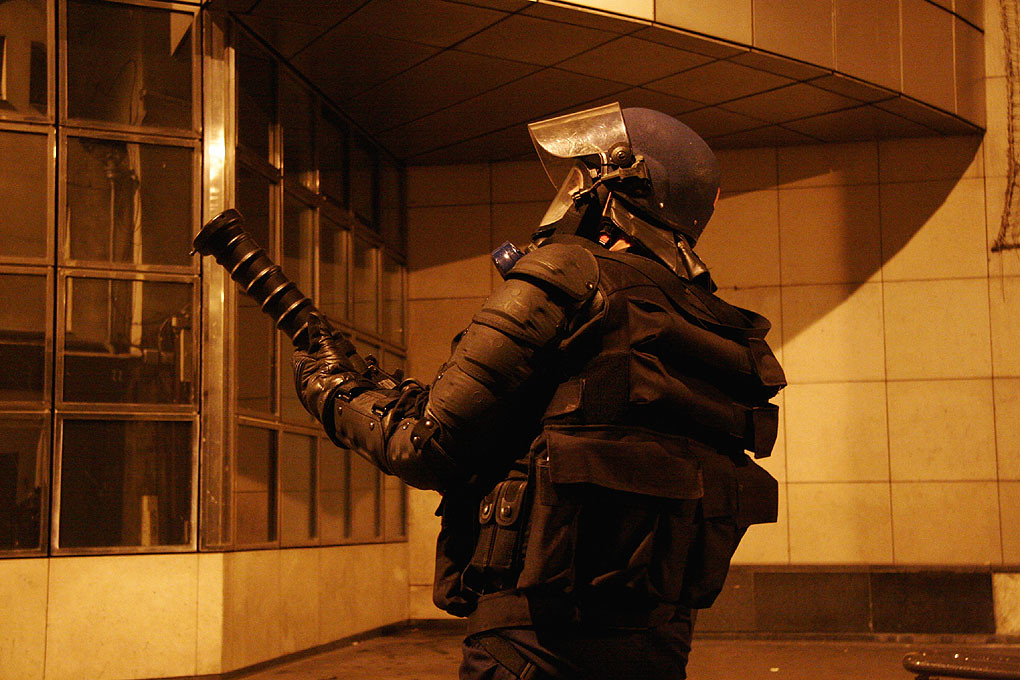
CONTEMPORARY TERRORISM
Since the 1950s, terrorist acts perpetrated on French soil have come from distinct types of groups. Most prominent in the 1950s and the 1960s were anti-colonial movements, followed by right-wing ones. Those that rose to power in the 1970s and the 1980s were groups that espoused a radical leftist and separatist philosophy in Corsica and the Basque Country. In the 1980s, jihadi, or Islamic, terrorism emerged in France that labeled it as a new peril. Since the 1990s, the country has been under threat from nationalist movements while is now facing religious terrorism. France is now observing a double-track expansion in terrorist threats, the first of them being domestic while the second international (since 2015). Despite a decline in the number of religiously motivated terrorist attacks in 2021, far-right movements also intimidate the public while some EU countries consider them as distressing as jihadism.
So far terror groups have not targeted Poland nor has the Central European country been a place from which the terrorists operate. Nonetheless, Poland is a transit country for some. There is some ground to reflect on a potential terrorist threat in Central and Eastern European states as it is inherently intertwined with foreign policy and involvement in international alliances. Some say Poland could become a target for terrorists due to a number of factors, including the country’s membership in the EU and NATO, its military presence in foreign missions, or permanent cooperation with the United States––an arch enemy of terror groups and whose position of a global superpower enfeebled after quitting Afghanistan and handing power to the Taliban. Other reasons for targeting Poland could be its involvement in missions in terrorist-controlled regions, a common border with conflict-ravaged Ukraine, its position on the eastern wing of the EU and NATO, and domestic political disputes.
The level of terrorist threat in Poland remains low compared to France yet this does not exclude efforts to strengthen methods and means to counteract terrorism. Through a set of solutions used in France, Poland can boost its anti-terrorist schemes and operational skills of counterterrorism services while educating society on the importance of some emerging threats and challenges. Constant efforts to coordinate and oversee all entities vulnerable to terrorist threats are indispensable for state security agencies to develop properly. Thus Poland needs to learn through France’s experience of combatting terrorism to strengthen its internal security and build up anti-terrorist potential in the EU. The most effective tool for combatting terrorism is through counteracting thus Poland should use proven methods, or those that France has continuously enhanced since 2015.
State authorities in France are centering all efforts on eradicating a terrorist threat. In Poland anti-terrorist activities are distinguished from counterterrorism. Responding to threats and terro acts and rearranging the systém for counteracting terrorism are treated separately as these activities differ due to the distinct levels of threat in the two countries. France is constantly struggling against terrorism at home and abroad while Poland eradicates emerging threats through its dedicated agencies, by preventing terrorist attacks or an increase in potential danger. Although the level of terrorism threat remains lower in EU states in the bloc’s center and east than in the west, Ukraine and Russia are home to the biggest number of insurgents on the continent. Of all people killed in Islamist attacks in 1979–2019, some 52 percent died in Russia while Ukraine is Europe’s number one country where terror groups have an impact on its domestic affairs, according to the Global Terrorism Index. In addition, Belarus is exerting migration pressure on neighboring countries where migrants, mostly from the Middle East, seek to illegally cross the border. Thus EU nations in the west and the east are obliged to offer a constant response to threats.
COUNTERTERRORISM LAWS IN POLAND AND FRANCE
France’s anti-terror legislation (la loi renforçant la sécurité intérieure et la lutte contre le terrorisme) contained some provisions allowing for enhanced cooperation between services, with acceptance from French citizens. Under the act, law enforcement authorities are allowed to establish security zones around places of events that they consider to be vulnerable to attack. The law also made it possible to shut down places of worship promoting radical ideas and bolster surveillance powers. The French anti-terror bill allows police to continue to carry out house raids or arrests due to possible weapons and explosives. The legislation addressed cyber space and measures to monitor wireless communications. It also extended border controls amid the risk from terrorists arriving in the country from the Middle East and Africa.
Polish state authorities brought into focus a set of legal tools for combatting emerging terrorist threats. So far measures were deconcentrated and thus did not ensure proper cooperation between specific agencies. As cross-border terrorist acts in Europe differ in nature, with various methods and means used, there was a need to devise adequate tools for identifying and assessing threats before they were completely eradicated. Polish intelligence services had to be prepared to take decisive and immediate action in the event of a terrorist attack and deal with its consequences. To ensure an appropriate level of cooperation, it was necessary to develop a system involving all services, bodies, and institutions––including local authorities, private businesses, and members of civil society––into multidimensional activities to combat terrorism. The legislation stipulates four phases, each defining efforts to handle terrorism: 1) prevention – by anticipating and sanctioning any deeds bearing the hallmarks of terrorism, 2) preparedness – by devising an action plan to take control and contain terrorism-related disruption, 3) response – by (re)arranging institutes tasked with destroying threats and mitigating terrorism-related disruption, and 4) reconstruction – through remodelled systems and added updates to ensure better response in the future. Under the law, it is mandatory to register prepaid SIM cards and counteract the threat of unmanned aerial vehicles. Furthermore, the legislation contains provisions that regulate carrying firearms.
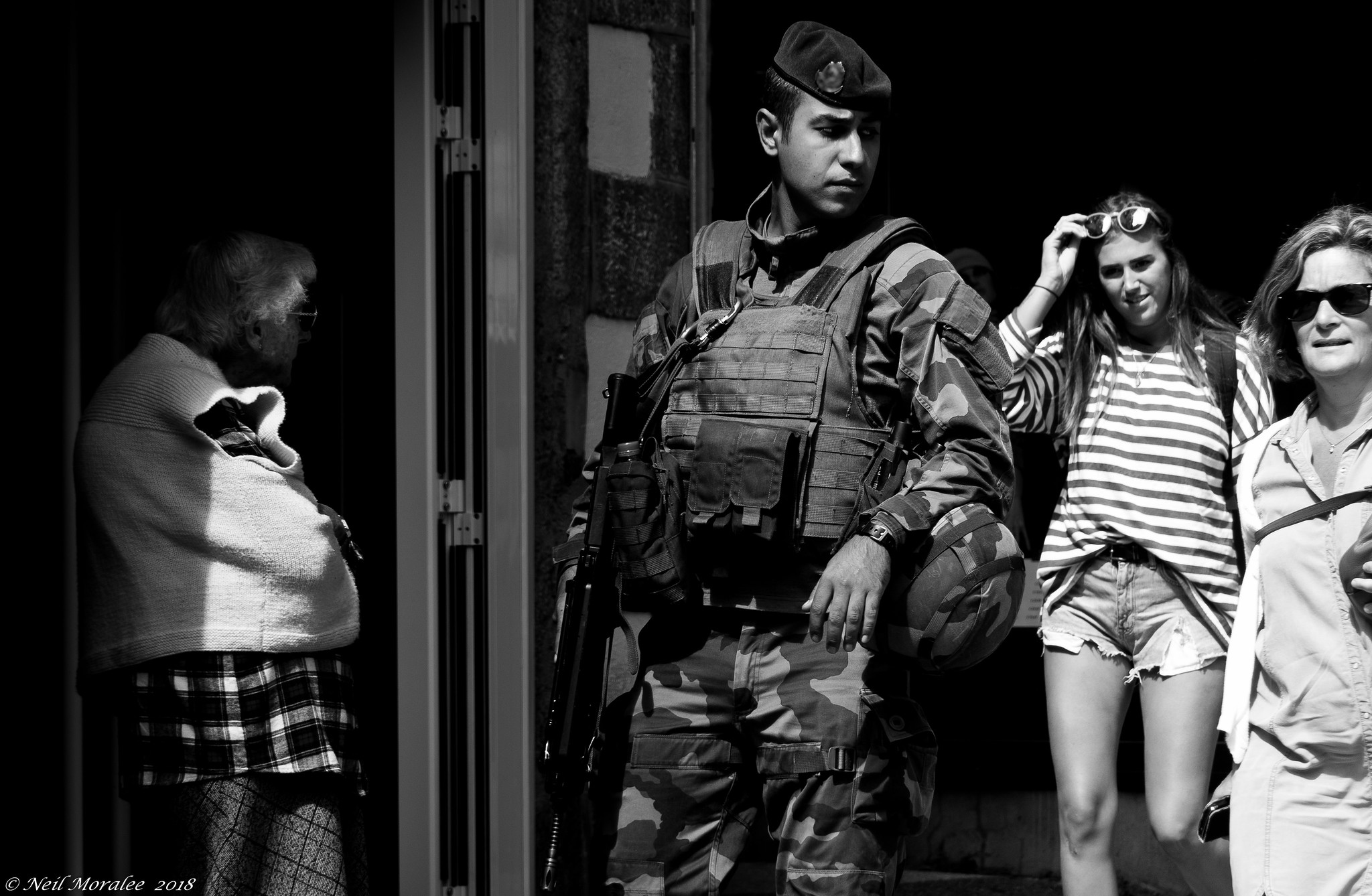
COUNTERTERRORISM AGENCIES
Those agencies operating in Poland and France are special services, police, gendarmerie, and the army. Cooperation between French law enforcement agencies is key for a long-term security strategy. Through gathering economic or technological intelligence, they can respond promptly to terrorism-related threats. The list of French intelligence agencies includes the General Directorate for External Security (DGSE), the General Directorate for Internal Security (DGSI), the Directorate of Intelligence and Security of Defense (DRSD), the Directorate of Military Intelligence (DRM), the National Directorate of the Intelligence and Customs Investigations (DNRED), and the Intelligence Processing and Action Against Clandestine Financial Circuits (TRACFIN). The country’s top counterterrorism outlets are the Research and Intervention Brigade (BRI), Brigade Anticommando (BAC), RAID, the Companies for Republican Security (CRS), and the National Gendarmerie Intervention Group (GIGN and AGIGN).
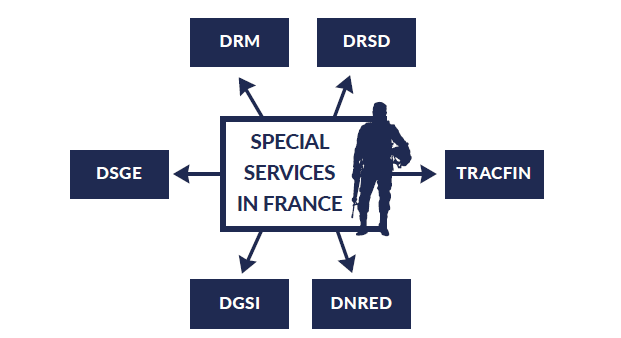
Consultations on counterterrorism efforts made by the DGSE took place after the agency had conducted armed and antiterrorist operations abroad. Their main objective was to determine which unit would have primacy of action during terrorist acts outside France. Eventually, it was GIGN that was tasked with interventions, special operations, and missions abroad. The organization which coordinates the use of the French special forces is the Special Operations Command; it reports to the Chief of the Defense Staff and the President.
Earlier those in charge of investigating international terrorism were the General Directorate for Internal Security and the General Directorate of the National Police while agencies of the National Gendarmerie and the National Police looked into terror acts on French soil. Now this distinction is slowly expiring as many agencies operate on many levels amid the high level of terror alert in the country, adding efforts to counteract terrorism to almost all French services. Interestingly, some units of France’s Municipal Police, the local police of towns and cities in France outside the capital, have participated in a training program to counterterrorism.
Placing a terrorism suspect under non-stop surveillance involves twenty officers per day thus it is necessary to delegate more than 400,000 law enforcement agents to monitor all individuals registered on France’s database of suspected terrorists. The situation is challenging despite spending $30 billion on security and $64 billion on defense in 2018. As of December 2018, there were 20,500 people suspected of terrorism in France. There is a rise in the number of French women joining the Islamic State militant group. There were 382 back in 2019 while 25 percent of female French soldiers who served in the Middle East converted to Islam.
In Poland, special services occupy a pivotal role in taking measures and ensuring state security through gathering intelligence on terrorist threats. These agencies are mostly ordained to maintain the appropriate level of security, shield national interests, counteract threats from outside and domestic agents, and efforts to counteract terrorism. In Polish five agencies were given the status of special services: the Internal Security Agency (ABW), the Foreign Intelligence Agency (AW), the Central Anticorruption Bureau (CBA), the Military Intelligence Service (SWW), and the Military Counterintelligence Service (SKW). They all take an active part in combatting terrorism. The Internal Security Agency serves a major role in detecting terrorist threats. It is responsible for analyzing threats, also through alerts of a credible terrorism threat. The head of the Internal Security Agency was granted the power to coordinate intelligence and security activities to prevent and combat terrorist threats. Services in charge of combatting domestic terrorism in Poland are the Police, the Border Guard (SG), the National Revenue Administration (KAS), and the Military Gendarmerie (ŻW). Also involved could be the State Protection Service (SOP), the State Fire Service, and the Government Center for Security (RCB).
Polish state authorities set up counterterrorism units for some ad hoc purposes. These are dedicated police and armed units endowed with an organizational structure, combat tools and methods, specialized equipment, training infrastructure, and logistics facilities. Their tasks refer to terrorism-related emergencies and are designed to ensure public safety. With extended powers, Poland’s Police is now the country’s top law enforcement agency capable of carrying out counterterrorism missions. A unified counterterrorism service was founded; it consists of the Central Counterterrorist Unit (BOA) alongside some autonomous counterterrorism branches of the Polish Police.
The number one law enforcement agency within the Polish Police is the Antiterrorist Operations Bureau of the National Police Headquarters (BOA KGP). BOA relies upon autonomous counterterrorism units of the police. They report to the chief constable of the provincial police or the Metropolitan Police Authority while local branches where they are located provide human resources, logistics, or technical support services. Counterterrorism police outlets conduct combat operations or support rescue operations.
Branches whose mission is to combat terrorism through offensive operations include Military Units Formoza, Commando Military Unit (based in Lubliniec), Military Unit GROM, Military Unit AGAT, Military Unit Nil, 7th Special Operations Squadron, and Special Military Gendarmerie Unit headquartered in Warsaw. The whole counterterrorism task force involves officers or soldiers of the Police, the Border Guard, the Internal Security Agency, the Military Gendarmerie, and the Armed Forces of the Republic of Poland. Of utmost importance in case of a terrorism event are efforts made by BOA and some autonomous police units having priority before other actions.
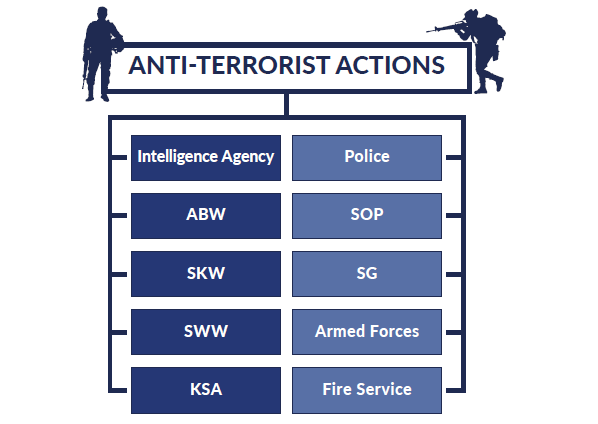
Poland and France are both members of the ATLAS network, an association of the police tactical units of EU nations. The ATLAS network was set up for information exchange, training cooperation between EU law enforcement agencies, and staging anti-terrorism drills. Back in 2004–2005, Poland’s National Police Headquarters forged cooperation with France’s GIGN and RAID to hold joint drills, also those including sniffer dogs, to practice counterterrorism tactics through training sessions. Furthermore, BOA KGP has created mechanisms of permanent cooperation with France’s RAID.
COMBAT SYSTEMS AGAINST TERRORISM
The security policy involving strategies, guidelines, and schemes is key for achieving goals. A properly functioning state develops an approach embracing all circumstances. New ideas emerge upon the need analysis and pursuits for a systemic change. Being aware of factors behind shifts that occur in some milieus, the state’s potential and how some entities could behave could help work out future solutions. An ability to forecast future trends is fundamental to maintain security as there is a number of factors influencing it: past and future activities, the analysis of milieus, and watchful verification of threats and opportunities. Security forecasting is intertwined with state policy: assessing risks properly and identifying threats exert an impact on the country’s foreign policy, national security, and its defense potential. After a string of terrorist attacks on European soil in late 2020, French President Emmanuel Macron urged Europe to tighten cooperation between countries of the visa-free Schengen zone. Macron’s proposal included intensifying joint border protection with a real security taskforce at the external borders.
France’s counterpart of the Polish anti-terror system is what is known as the Vigipirate plan, the country’s national security alert scheme. The program dates back to 1978 when France and Europe were faced with the first waves of terror from extremists and insurgents. The Vigipirate plan was formally implemented in 1995 and last updated in December 2016. It rests on three pillars:
- Development of a culture of individual and collective security extended to all of society;
- Creation of three levels adapted to the threat and made concrete through logos displayed in public areas:
(a) Vigilance (Le niveau de «vigilance») – includes security measures, also through supervising public transportation and public places.
(b) Reinforced security (Le niveau «sécurité renforcée – risque attentat») – prompts a response to the high or even very high level of terrorist threat. In addition to protecting vulnerable facilities, including airports, stations, and places of worship, it is possible to identify additional places that require reinforced surveillance.
(c) Attack emergency (Le troisième niveau, intitulé «urgence attentat») – introduced directly after a terrorist attack or to identify the threat or the terrorist cell. Its duration is limited to crisis management.
- Implementation of measures reinforcing government action against the threat of terrorism.
Poland’s anti-terror system relies upon a couple of subsystems of the state’s internal security, where it is possible to take action depending on a threat. Specific solutions could be added in the event of a terrorist threat as specified in the Act on Anti-terrorist Activities. Thus these efforts cannot be isolated from other areas of domestic security. Terrorism can ripple effects through a whole array of domains and thus combatting this threat shall rely upon various state agencies. The Polish anti-terror system involves the three levels:
1) strategic – where the Prime Minister and the Council of Ministers take systemic action to guarantee anti-terrorist protection throughout the country. The country’s advisory bodies are also tasked with developing an anti-terrorist policy. These include Interministerial Team for Terrorist Threats, Collegium for Secret Services, and Government Team for Crisis Management (RZZK), while the Interior Minister is a vital link of the whole system.
2) operational – where the Internal Security Agency’s Terrorism Prevention Centre of Excellence and the Government Center for Security jointly coordinate information flow between other agencies and bodies within the country’s anti-terrorist system and monitor potential terrorist threats (or crisis management, in case of the latter agency);
3) tactical – involving services, bodies, and institutes in charge of anti-terrorist protection.
Countering terrorist threats covers a broad spectrum of means to neutralize the terrorist threat. It embraces both anti-terrorist (defense) schemes intended to protect people and facilities and counterterrorism efforts whose top mission is to prevent, halt, or annihilate any terrorism-related crime. Anti-terrorism aims to shield people and facilities and restrict access to some institutions, files, and equipment. Another domain of interest is efforts to combat espionage, sabotage, damage, and theft. Counterterrorism is defined as an offensive manner of combatting terrorism by the country’s specialized taskforce at home or abroad, the latter being part of an allied mission. The following list contains some fundamental ingredients of any anti-terror system ensuring its smooth functioning:
– generally applicable law,
– agencies involved in the anti-terrorist system and their structure,
– means, tools, and potential,
– intelligence flow,
– risk analysis and monitoring,
– communications,
– training and educational agenda,
– financial resources.
The fight against terrorism has been on for decades now as the threat can take on different forms that states tend to define disparately. It is challenging for state authorities to develop new means, a method that entails innovative schemes and solutions. Intelligence and law enforcement services tend to borrow methods from other agencies and states or to use them as groundwork for new domestic outlets. Anti-terrorist mechanisms need constant updates to better respond to ongoing terrorist challenges. In their security agenda, EU nations shall convey similar solutions to tackle terrorism, a key feature in tightening cooperation between dedicated branches. If terrorists move within the Schengen area, they should be detained through transnational effort. Thus the national security scheme to tackle terrorism shall contain the following:
– Anti-terrorism – it shall constitute a number one approach in government strategies as the pivotal factor affecting the state level of security.
– Special services – serve a fundamental role for gathered intelligence while their covert missions allow surveillance of many potentially high-risk domains. They include operations both at home and abroad.
– Armed forces – with a properly trained army, both target-focused and ready to respond immediately, any state is able to mount a counteroffensive and somewhat repel a potential assailant.
– Counterterrorism – through operations conducted by branches dedicated for combatting terrorism-related threats.
– Diplomacy – by getting involved in global alliance, countries have bigger potential to tackle terrorism. An example is being a NATO member state or devising a common anti-terrorist policy for all EU nations.
– Internal security – it is vital to ensure peace and security at home to conduct operations abroad, possible thanks to protecting population and expanding state structures.
– State democracy – popular support for counterterrorist missions allows setting up new institutes.
– Diversified anti-terrorist operations – in addition to security-related missions, it is important to raise awareness of terrorism and include national and ethnic minorities into the public debate.
– Identifying threats – through defining plausible enemies and their origin to adopt methods and means of operation.
– Intelligence cooperation – sharing or exchange of politically useful secret information between states.
The nature of terrorism has changed since September 11 attacks and so has the contemporary perception of terrorism. A new definition of terrorism was coined back then, bringing counterterrorism to the fore as a number one goal of Western nations locked in the “global war on terrorism.” Many states have adjusted their national policies or legislation and delineated a range of means and methods for internal security. Poland and France are among the EU nations that introduced most updates to their domestic systems and got involved in foreign operations.
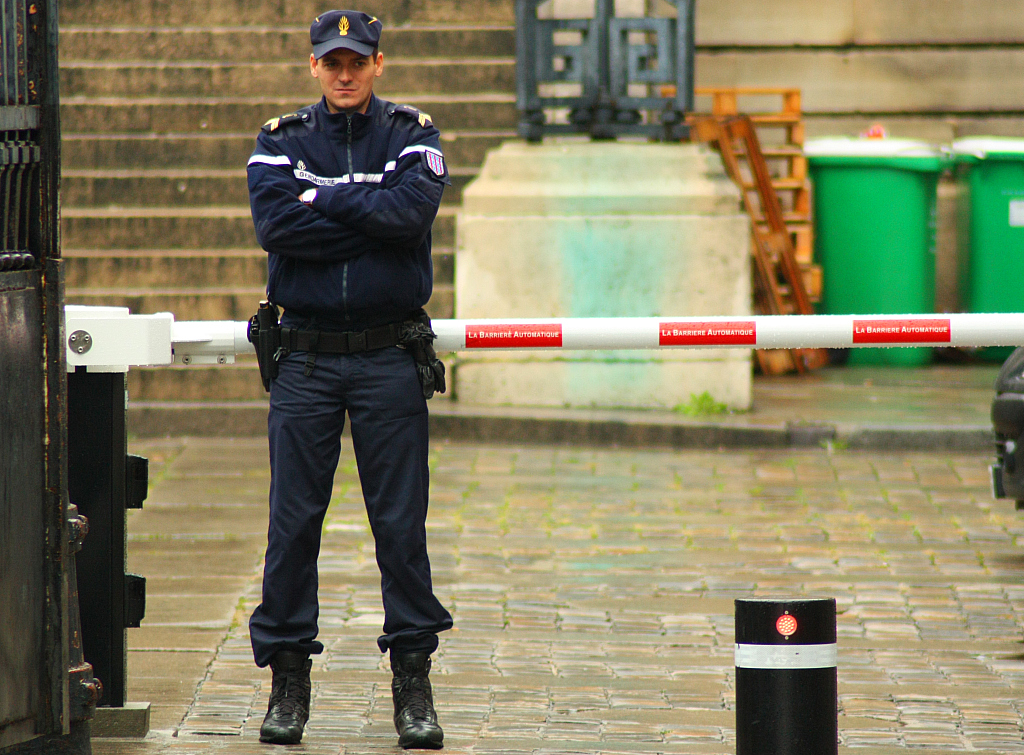
GOODS PRACTICES OF POLAND AND FRANCE IN DEVELOPING ANTI-TERRORIST SOLUTIONS
Now systemic solutions need to be streamlined to effectively respond to security challenges. Furthermore, states shall rethink their security models amid dynamic shifts in Europe and elsewhere. Applying means and methods modeled on those already employed in France will reduce the likelihood of a terrorist attack in Poland. Many anti-terrorist systems are not verified until after a terrorist act. France has had the opportunity to revamp its system after suffering multiple attacks so Poland should take a lesson as the Central European country is not yet struggling with terrorism. It is best time to reinforce anti-terrorist agenda.
Tackling terrorism is a multifaceted effort that goes hand in hand with a comprehensive strategy allowing state agencies to detain suspects and ensure security. It is vital to handle terrorist threats not only in Poland and France, but anywhere across the globe. It is essential that each component (analysis, planning, organizing, coordinating, controlling, responding, reorganizing, evaluating, and recommending) be carried out continuously to review risks and identify top priority goals. All of these successive features are critical to avoiding a threat or responding during an attack. They also allow enhancing flaws due to human factor. Thus it should be a top priority to involve all agencies in performing tasks for reinforcing the country’s anti-terror system.
It is best to commence a raft of long-term projects such as:
– verifying risk factors for radicalization,
– developing reintegration facilities for radicalized individuals,
– providing better protection from inappropriate content online,
– building up intelligence and surveillance,
– increasing nationwide resistance to terrorism,
– developing counter-radicalization programs targeting prison inmates,
– sharing preincident terrorism indicators to prevent acts of terror,
– determining content of religious education,
– reintegrating returning foreign fighters, especially minors,
– setting procedures to dismiss radicalized state officials,
– abducting people leaving EU countries to conduct terrorist acts abroad,
– granting powers to censor terrorist websites to the government,
– providing assistance and support to terrorism victims.
Another crucial ingredient of the anti-terror system using social media channels is constant communication between citizens and law enforcement agencies. Employing digital tools to transmit salient information should lay the groundwork for a sense of security and curb disinformation from fake accounts or terror groups in case of emergency. It is critical to use social media channels to notify law enforcement agencies of danger and indicate where exactly an act of terror took place.
Equally important is conducting a risk analysis to shield vulnerable areas. According to an analysis of terrorist acts perpetrated on French soil, the biggest threat of terrorist violence is in places that attract a bustling crowd: festivals, sports games, and rallies.
Neither Poland nor the Baltic states introduced mandatory training for health professionals in terrorism preparedness. Furthermore, this has not been included in professional training schemes. It is of utmost important to devise a legal solution while government agencies should ensure such instruction to most paramedics, specifically those in cities, where the risk of terrorist abuse is higher than elsewhere. Perhaps also municipal police officers should be trained how to handle terrorist threats as they are typically the first to arrive at a scene. Thus they should be capable of recognizing a threat and responding adequately to protect as many people as possible.
CONCLUSIONS
Post-attack procedures account for 15 percent of all anti-terrorist efforts. The fight against terrorism began many years ago but it is not until the first successful terrorist act that countries respond more effectively to related threats. It is when prevention takes place while people are informed about other foiled attacks. Relative security is maintained at all times prior to the attack. Some countries shall take a lesson from other nations to rethink their anti-terrorist programs. Europe marked fifteen years since the Madrid attack and five years since the Paris coordinated attacks. As long as services do not try to outrun terrorists, but only react to their activities after the fact, the terrorist threat will remain high everywhere across the globe, including Poland.
Now systemic solutions need to be streamlined to effectively respond to security challenges. Furthermore, states shall rethink their security models amid dynamic shifts in Europe and elsewhere. Applying means and methods modeled on those already used in France will reduce the likelihood of a terrorist attack in Poland. Similarly, France can take a lesson from its Polish peers. Many security experts recognize Poland’s anti-terror legislation as world’s best, describing it as a role model for the EU anti-terrorist policy.
Tackling terrorism is a multifaceted effort that goes hand in hand with a comprehensive strategy allowing state agencies to detain suspects and ensure security. It is vital to handle terrorist threats not only in Poland and France, but anywhere across the globe, making sure that each ingredient––including analysis, planning, organizing, coordinating, controlling, responding, reorganizing, evaluating, and recommending––be carried out continuously to review risks and identify top priority. All of these successive actions are critical to avoiding a threat or responding during an attack.
A point to remember while examining counterterrorism strategies is that allied worldwide cooperation is most effective once based on robust counterterrorism schemes locally. The terrorist threat in Europe is peculiar as no one knows how many terrorists there are, where they operate and what their plans are. In this light, what matters most are solutions worked out by allied states that depend one on another in the security theater worldwide. An update to local anti-terrorist policies should be augmented with some strategies developed by organizations seeking to establish a common security policy in all EU member states. Anti-terrorist agenda worldwide should embrace as many subsystems possible to cover economic, social, political, and legal aspects alongside some distinctive powers granted to counterterrorism agencies. Adding joint efforts to anti-terrorist policies at home will allow for implementing an anti-terror strategy adequately to an emerging danger.
The terrorist threat is permanent. There is no single effective method to handle it, but it is possible to offer a sustained response to emerging challenges across Europe. Of all EU nations, Poland and France now have the newest anti-terror systems. As hybrid warfare, a military strategy including also terrorism, is sweeping the world, other countries shall refit their policies and mount efforts to tackle terrorism. There are no border checks between the Schengen countries so that these nations do their best to protect their territory.
Read more in the newest book “Fight against terrorism. Polish solutions versus French experience,” available in English in December 2021. The book in Polish can be purchased here: https://bit.ly/3dQP7wY
AUTHOR’S BIO
Dr. Aleksander Olech – Director of the European Security Programme at the Institute of New Europe, Contributing Analyst at the Warsaw Institute. Ph.D. in Security Sciences. A graduate of the European Academy of Diplomacy. He gained research experience at the Université Jean Moulin III in Lyon, the Institute of International Relations in Prague, the Institute of Peace Support and Conflict Management in Vienna, the NATO Energy Security Centre of Excellence in Vilnius, and the Baltic Defence College in Tartu. Scholarship holder of the OSCE & UNODA Peace and Security Program and the Casimir Pulaski Foundation. His main research interests are terrorism, international cooperation for security in Eastern Europe, and the role of NATO and the EU with regards to hybrid threats.
All texts published by the Warsaw Institute Foundation may be disseminated on the condition that their origin is credited. Images may not be used without permission.















